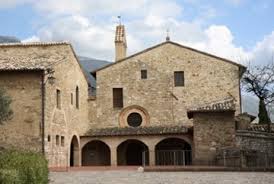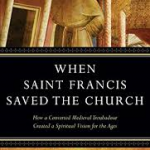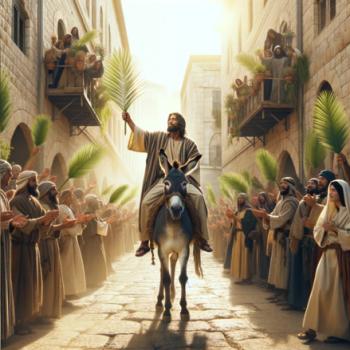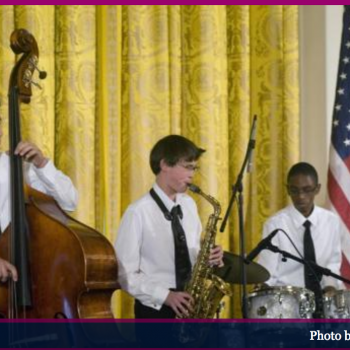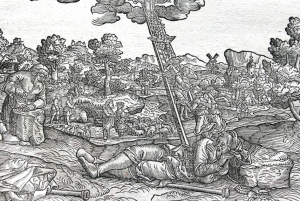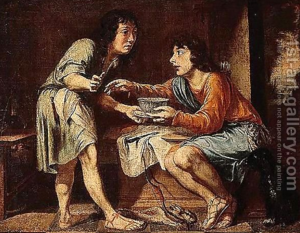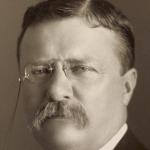I came to Assisi with two books, or parts of books in hand: pages 559-594, torn out of Rick Steves’ Italy, and Jon Sweeney’s When Saint Francis Saved the Church: How a Converted Medieval Troubadour Created a Spiritual Vision for the Ages. Both have served me well. Rick Steves got me around this spectacular hill town in Umbria—the right tickets to buy, cafés with wi fi, viewpoints, basilica tours.
Jon Sweeney’s book led me in another direction—an unexpected one—on a sort of pilgrimage, more internal than external. I’ve discovered a few things about Saint Francis and a good deal more about myself. Let’s see if I can put this into words.
Two Churches
I walked past the basilica of St. Clare out the Porta Nuova through the parking lot and down through olive groves to San Damiano, the small church in which Saint Francis is thought to have heard Jesus speak to him from the crucifix, telling him to build the church. Ever the literalist—he actually took Jesus’ words to the rich young ruler seriously, “You lack one thing; go, sell what you own, and give the money to the poor, and you will have treasure in heaven; then come, follow me”—Francis thought Jesus wanted him to rebuild the ruins of San Damiano. So he did.
Later, however, Francis came to realize that Jesus’ words were more expansive. His job was not to build this church but to build the church. He did that, too.
Two Goals
I wonder if I’ve operated in life with Francis’ first perspective: find a task at hand and get it done. I’m a good Methodist (more or less) who prays, “Put me to use, oh God.”
I’m pretty good at getting the job done. Whether at a seminary or college, I’ve thrown myself into my work, not so much in terms of endless hours as endless energy. I’ve never cowered from hard work, from teaching classes and getting grants and writing books.
The problem is that, like Francis, at least at first, I sometimes limit my vision to the task at hand. “Build my church, Francis,” so Francis set out to rebuild San Damiano. So I write syllabi, grade essays, and prepare classes.
Francis wasn’t wrong, exactly, but he missed, at first, the larger point. I think I sometimes miss the larger point, too. I see God’s will as a series of San Damianos—specific tasks in specific times and specific places—rather than a mobile, malleable, occasionally magnificent movement in the Spirit.
Had Francis continued to understand Jesus’ words as a mandate to rebuild San Damiano, we would have a very different Christian history. Francis would never, in Jon Sweeney’s words, have “saved the church.” We would have instead a very nice little stone church known as San Damiano.
Two Legacies
I hope the legacy of my life is not just a series of very nice little churches, a succession of pretty little San Damianos settled sweetly in olive groves. I hope my legacy is more expansive, carved out of my character rather than my jobs, out of my integrity rather than my books, out of my vision rather than my committee assignments.
I realize there shouldn’t be a tidy distinction between these: a good person should do a good job, an author with faith should write thoughtful books, a Christian professor should teach carefully and serve attentively on committees.
But I hope my attention to the smaller picture won’t efface the larger one: San Damiano got rebuilt, yes, but so did the church universal because Francis put the same energy it took to rebuild this church into living with abandon and attention to the words of Jesus and, in that way, rebuilding the church.
Two Sides of the Same Coin
What then did I learn as I left the bustling cobblestoned streets of Assisi and descended to the olive groves around San Damiano? This, I think.
Sometimes, the particular should be preeminent. Sometimes the small task proves significant. San Damiano—and not the church universal—became for Francis and Clare, the girl who had abandoned all because of Francis’ charisma, a place of respite. Clare spent her life as the mother superior of the Poor Clares at San Damiano. When Francis aged, he returned there and lived in a reed hut which Clare built for him and where, the story goes, she made shoes and stockings for his tired, bare feet and legs. It was there, too, that Francis composed his famed poem, “Canticle of the Sun.”
Yet the particular should always reflect God’s greater vision. We have to attend to the particular—to the tasks at hand as if they are charisms rather than chores.
Truth be told, the small and the large, the task-at-hand and God’s eternal vision, are two sides of the same coin. The grand vision into which God is inviting us progresses when we set stone upon stone, when we repair the small, apparently insignificant, ruins we inhabit day to day.

